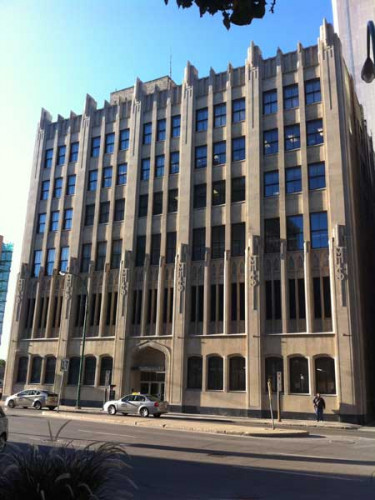- The telephone came to the province in 1878, just two years after Alexander Graham Bell received the first patent for this magical instrument. This was the first glimpse of telephony in the entire west and it came in the form of two instruments which had been brought in by Horace McDougall, Manager of the Northwest Telegraph Company in Winnipeg.
- Three years later, the city boasted of having 10 telephones on one line, which was assuredly more than any other city at that time. In addition, Winnipeg had 26 subscribers.
- A switchboard was installed in 1881 in a small room in the Caldwell building at McDermot and Main Street. It was located on the top floor in order to run telephone wires on the roof of the building. In those days an expansion plan did not usually include telephone poles. Wires were strung from roof to roof top and along fences. Poles were used only when the phone people ran out of roofs.
- The first telephone operators were young boys who became “telephone men.” Boys and young men had served as telegraph operators ever since Morse had ticked off his historic “what hath God wrought.” So why not put the boys at the telephone switchboards?
- The first official telephone directory was printed in Winnipeg in 1881 and listed 42 subscribers.

- Brandon was the first office in Manitoba to get dial phones back in 1917 while the first automatic exchange in Winnipeg was cutover for service in 1920. Six years later, the complete conversion from manual to dial service was completed. Winnipeg then had the distinction of being the first large city in Canada to have complete automatic service.
- The development of the Manitoba Government Telephones, the first such system on the continent, was begun in response to a growing demand for the principle of public ownership of public utilities. The official name designated by Order-in-Council No. 12545, dated January 15, 1908, was Manitoba Government Telephones.
- During the 1920s the phone book’s directions for using the telephone were extensive and a bit more sophisticated than they had been in the pioneering years. The advent of the automatic switching equipment now installed in many central offices made it necessary to tell customers how to use their new dial telephones. It was about this time that the Yellow Pages actually became yellow. They had previously been pink or white.
- World War II brought problems of its own—a tremendous demand for telephone service and shortages of manpower and materials. New installations were limited by the scarcity of basic raw materials -copper, nickel, zinc and tin, needed in the manufacturing of telephone equipment.
For more facts on the history of the telephone in Manitoba, go to: http://www.mhs.mb.ca/docs/transactions/3/telephone.shtml
Courtesy of the Manitoba Historical Society






